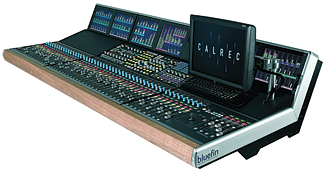Calrec Helps Move Global TV Into Digital
TORONTO
For more than a year, I've been in the thick of Global TV's massive project that is fundamentally changing and improving the way we operate. We're building an HD infrastructure at the same time that we regionalize production control to make things more efficient. CIII (pronounced c-triple-i) is Global's flagship facility, and the one I know best. It's the one I was hired to turn upside down. All throughout the Global network, basic, integrated changes are taking place.
ONE BIG CHALLENGE

The Calrec Omega audio console Global TV offered me a challenge I couldn't turn down—the complete HD rebuilding of an analog plant. I'm a curious person and love technology and investigating new things. In the middle of a design, I tend to see things from the component level, looking in the marketplace for something new that meets my needs.
Of course, it's even better when there's an off-the-shelf product that works just the way I need it to. Working on this project, I was fortunate enough to have that experience with several components, among them Calrec Audio's Hydra networking system and its Omega audio mixing consoles.
Hydra creates a network for sharing I/O resources and control data between digital audio consoles. Here at CIII, Hydra has allowed us to put together a distributed processing system without running a massive number of cables. All the signals travel via a pair of gigabit Ethernet fibers that run data at up to 1,000 Mbps. To add equipment, we just plug it into the Hydra interface box and program the console to recognize it.
MULTIPLE AUDIOS DELIVERED BY FIBER
The new CIII plant is laid out with three control rooms, three studios and a main equipment room. Each control room has a Calrec Omega console, and from there two cables (main and backup) run to the equipment room. The studio interface has about 32 mic inputs that appear on the two fibers. The 16 line outputs also travel on the fibers. There's no longer one cable per feed. Instead, when we get the feeds into the equipment room, we put them into the switches, and the work is done there. Most of the Hydra boxes are 32 AES in and 32 AES out, and we have these distributed throughout the equipment room for the intercom, telephone bridges and satellite receiver—anywhere there's audio.
We have three Omega mixing consoles here and Global has also deployed them in its regional production centers. We also have Calrecs in our OB trucks. The Omega has a compact size, a lot of power and resiliency— all due to the Bluefin high density signal processing inside. While some of our operators were unfamiliar with the Calrec interface at first, they were won over when they realized how easy the console is to configure.
I'd like to report that the Omega console we have up and running has been flawless—and it pretty much was—until an operator dropped a piece of heavy equipment, breaking some knobs. Luckily, Studio Consultants, Calrec's rep in New York, was able to get replacement parts here the next day.
Global TV's reconfiguration is being phased in and is set to be complete next spring. This is a challenging project, but it's the challenges (and successes) that make my job worthwhile.
For additional information, contact Calrec Audio Ltd. at 44-1422-842159 or visit www.calrec.com.
Get the TV Tech Newsletter
The professional video industry's #1 source for news, trends and product and tech information. Sign up below.
